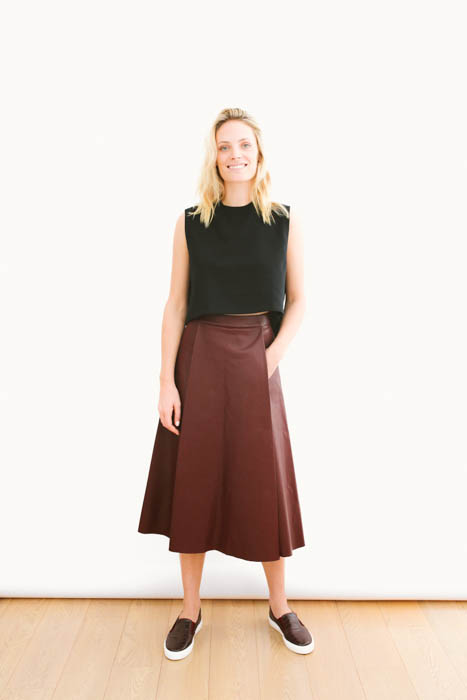A Boy Named Sue – What You Can Learn From Their Sustainability Triangle
Story Highlights
The Founders of A Boy Named Sue launched their Hong Kong based conscious e-shop/online boutique to change the negative perception of green fashion
Learn about the ABNS Sustainability Triangle which includes Eco, Social, and Local traits.
There are many views and mixed perceptions when it comes conscious fashion. To help clarify the misconceptions, the ladies behind A Boy Named Sue (a Hong Kong e-shop/online boutique that sells cool clothes with a conscience) launched their company to simply “change the perception that green fashion is either hemp granola clothing or on the flip side, too conceptual to wear out to a dinner with your girlfriends.”
Read ahead to meet the pioneers of conscious fashion: Samantha Wong (who goes by Sam) and Tania Reinert-Shchelkanovtseva. Together, they help “bring together designers with a visionary approach, blending goodwill with aesthetics.”
Q | Tell us about yourselves and what inspired you to launch A Boy Named Sue
We met through fashion blogging. Tania came from a financial background and wanted an outlet where she could creatively express herself. Sam was already working as a fashion analyst for an online retailer. It all started off with a worldwide blogger collaboration, called The 15/30 Project. Each blogger had to curate a capsule wardrobe of only 15 items to wear for 30 days (a month) to promote creativity through sustainability, the concept of cost per wear and a culture that doesn’t promote reckless fast fashion shopping.
After that, we wanted to take the idea further and began researching designers who incorporated a sustainable ethos into their collections while maintaining a design aesthetic that would seamlessly blend into the contemporary wardrobe. We wanted to change the perception that green fashion was either hemp granola clothing or on the flip side, too conceptual to wear out to a dinner with your girlfriends. Since we came from a background in fashion blogging, online retail seemed like the best place for us to create a platform where ethical and socially conscious clothing could be made available to the global consumer. Thus A Boy Named Sue came to being.
Q | Can you tell us about the culture in Hong Kong? What do you love about it? What’s the conscious culture landscape there?
Like New York, Hong Kong is a fast paced but transient city and the people are here mostly because of work. The city has a strong flavor that most people here either love it or hate it. Those who love it, love it for its convenience (the subway here, unlike New York, is incredible efficient and clean) and the landscape where one can work 9-5 in a corporate skyscraper and escape to the beach and sea during the weekends. On the other hand, those who hate it , do so because of the tropical weather (100% humidity), the soaring rental prices in a very crowded environment and the consumer driven landscape.
We personally love how open people are here to new ideas and creative startups. We had a lot of support from the media, our friends, family and other creatives who used their skills in photography, social media and film to help us start A Boy Named Sue.
Q | What is the meaning behind A Boy Named Sue
‘A Boy Named Sue’ was originally the title of a song by Johnny Cash. We just loved how the name had a narrative quality to it which reflects our clothes which all have stories behind them. The words also formed a triangle when placed vertically, reflecting our brand’s Sustainability Triangle– a ‘three corner’ ethos that determines which eco brands to showcase on A Boy Named Sue.
Q | We know you fill your store with apparel, accessories, and lifestyle items – how do you choose the designers you work with?
The Sustainability Triangle is how we determine which designers to take on. The brands have to adhere to at least one the following traits:
a. Eco: designers who promote environmental stewardship through careful analysis of their production chains, choice of materials, reduction in energy input and closed loop waste disposal to reduce their ecological footprint.
b: Social: brands that put the craftsmen first. These designers seek to have a social impact by providing a solution to an issue within a community close to their heart; through creating employment, ensuring that fair labour conditions are met, helping marginalized members of the society or sustaining a dying craft.
c: Local: designers who produce in Asia, and especially in Hong Kong. Here our goal is to promote creativity in a consumer-driven society and hopefully encourage the designers to work with eco-friendly practices and sustainable materials.

Q | Tell us about the long-term vision for A Boy Named Sue?
The greatest hurdle for an eco-fashion business is the social mindset most people have towards the environment and their clothing choices. Fast fashion companies have marketed themselves in a way that makes buying clothes appear very easy, cheap and harmless. We hope to gradually educate people on the harmful effects of the fast fashion industry in an approachable way that doesn’t condemn ignorance but brings awareness to issues of slave labour to the pollution and waste caused through garment production.
The online retail is a practical solution for consumers who want to make a difference where we strive to bridge the gap between ethics and aesthetics. Our slogan ‘Cool Clothes with a Conscience’ hint at that already – we want to be able to wear clothes that are ethically produced but can also blend into a wardrobe of tees and jeans.
Q | What’s up next for A Boy Named Sue?
Good question, we are still on the learning curve. We hope to expand into more lifestyle products in the near future while we’re always on the lookout for new ethical fashion designers to add to our collections. We also think social media is an incredible medium to touch our consumers so we’ll be partnering up with some bloggers and digital creatives to make some cool content!
Q | We know you are about to launch a column on consciousmagazine.co as one of our editorial collaborators – why is that important to you?
Like Conscious Magazine, A Boy Named Sue believes in getting down to the truth behind our culture of production and consumption. The reality is is that fast fashion exists because of our desire for a cheap thrill rather than a genuine story, because of our disregard for the people who make our clothes and the environment, and the disjointed relationship between those who make our clothes and those who buy them. Throughout this column, we hope to continue our mission: of telling stories of the designers who are fighting to make a difference, the real issues and the detrimental effects of fast fashion on the global environment. And who knows, perhaps a reader will want to join this cause and start by evaluating their own garment purchases and begin to shop more consciously.
What I love to also takeaway from this interview is that conscious fashion is becoming a global conversation. This is something to take note of.
Learn. Connect. Act.
Learn more about A Boy Named Sue
Connect via Facebook and Twitter
From the Editor
At Conscious, we are inspired by remarkable people, and so we set out to tell stories that highlight real human interactions and human dignity. You can read more stories like this when you pick up your copy of Conscious Magazine. Subscribe today via our Conscious Shop and subscribe to Conscious Updates.
Images: A Boy Named Sue




